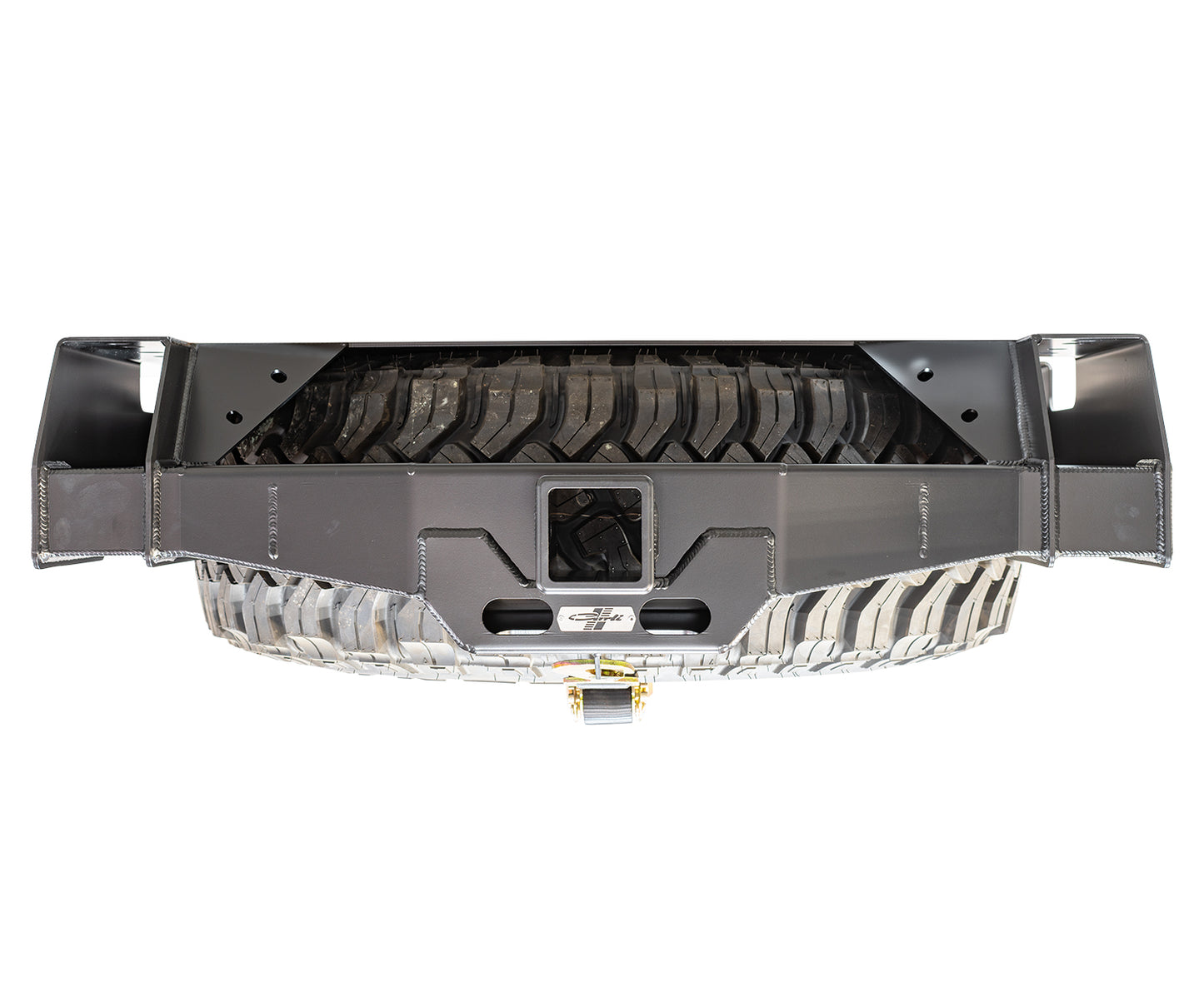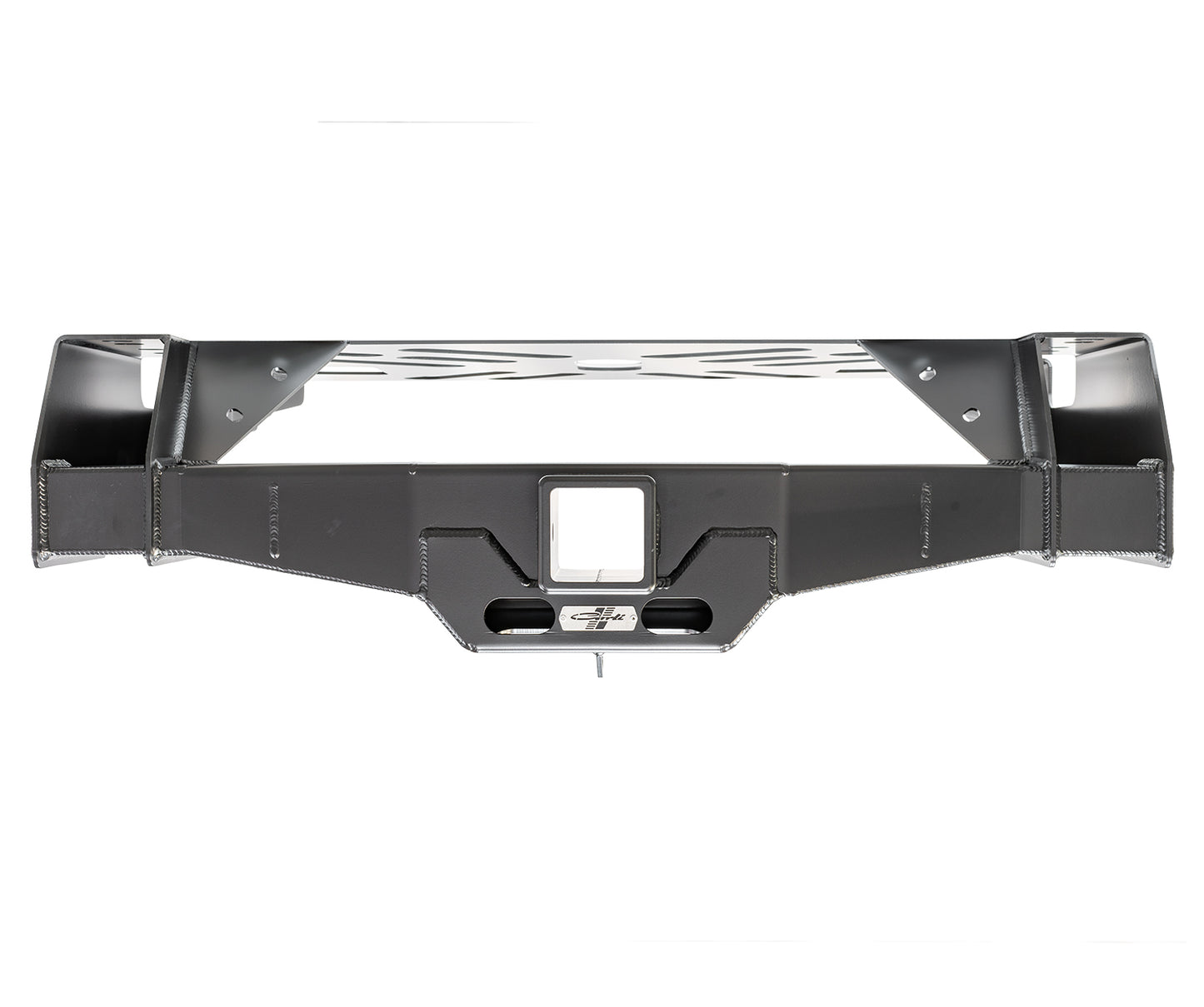Carli
CARLI - 17-23 FORD F250/350 4X4 FORD TROPHY HITCH
CARLI - 17-23 FORD F250/350 4X4 FORD TROPHY HITCH
Couldn't load pickup availability
17-23 FORD F250/350 4X4 FORD TROPHY HITCH
– Direct Bolt in, Rated to 16,000lbs., 3″ Hitch Receiver
– 3/16″ and 1/4″ Cold-Rolled American Steel
– Utilizes Factory Winch + 3-way Tie-Down to Secure Spare
– 38″ Spare Tire in the Factory Location
– May Require Exhaust Modification
– Requires 5/8″ x 4″ (usable shank) Hitch Pin
– Fitment: 2017+ F250/F350
Description
It all started with the purchase of our 2017 F250 Super Duty… Our previous 2011 had no issue with a full size (I’m talking OUR full-size – 37×13.5″) tire fitting in the factory location. This was new territory for us as the RAM platform with which we’re so familiar wouldn’t even allow a 35 in the factory location without contacting the axle center-section to the tire sidewall on full compression of the rear suspension. The 2011-16 Fords spoiled us. Once we got through the R&D on our 2.5″ Lift Ford Systems for the 17+ “Alumiduty” platform, we went to throw in a full size spare to match our 37×13.5″ Toyo R/T and, much to our Surprise, it took a floor jack to wedge it into the factory location. This wasn’t even an aggressive mud terrain, what gives, Ford??
It may not have been easy to get in and required deflation to remove (and carrying a compressor to inflate) but it was doable. Fast forward to the 4.5″ System Development and the monstrous Super Duty Wheel Wells exhibited by our customers posting pictures of their 40″ meats on our production 4.5″ systems and we knew something had to be done. These customers claimed only “minor trimming” to fit the 40’s so we stepped up to 38″ x 13.5″ M/T knowing full well that, unlike most, we’d be cycling the FULL length of travel and doing it often so it was best to err on the side of caution when stuffing bigger tires. They were a success – very minimal trimming tucked the 38″ without issue but the spare was ratchet strapped in the bed as there was no way to fit it under the bed. Not sure you’d want to crank it into the factory hitch even if it would fit – we saw video evidence of two of our customers running whoop sections dropping their oversized spare tires from the bottom of the bed thanks to a broken factory winch cable. The factory winch cable is far from party-rated!
Sage Carli is an avid camper and hunter; most trips, these activities are in extremely remote locations and the pickup bed becomes both his hotel room and supply house. We experimented with several options, back bumper with a swing out? Naw, who the hell wants to lift a 38″ mounted spare if they don’t have to; also, how do you build it strong enough to withstand movement when abusing it as hard as we do? For fun, he started looking to the factory hitch and found that there was sufficient room between the frame rails to mount the tire but the factory hitch would have to go. This allowed him to solve several issues – the factory safety chain mechanism is a nightmare. Sage kept the factory design but eased installation of the chain to the hitch. the construction of the hitch is massively strong, boxed 1/4″ cold-rolled steel where it matters and powder-coated for corrosion resistance. It maintains the factory spare tire winch to raise and lower the tire but includes a custom 3-Way Ratchet strap and 3 Heavy Duty D Rings to secure the tire in place once the winch gets it into position and unload the weight from the factory cable.
Testing: Class Five?
We can build a bad-ass hitch, there’s no question about it. With the interest we received from all of you, we wanted to back our confidence with legit testing. For this, we contacted Element Materials Technology in Des Moines, IA. Our request was to test the hitch to 12,000lbs figuring this is where a 2″ receiver would likely top-out in a bumper-pull style trailer. Once Element got their hands on the hitch, they took the initiative to bump it. I Quote:

Come to find out, Class 5 doesn’t exist; 4 is really the highest rated hitch “class”. Anything tested over 4 goes into the 4+ category often referred to as 5. We wanted to test this hitch to SAE standards; their recommendation “SAE J684 2014 to Class 4+ 16,000lbs GCVWR”.
The result, per Element: “The Class 4+ (16,000 lbs GVWR) Weight Carrying hitch component described herein complies with all appropriate portions of the SAE J684-2014.”
It was requested that we send 2 identical hitches for testing – one would be tested to the standard (originally 12K, bumped to a staggering 16K once received and analyzed by test facility) and the second would be tested to failure at their max 20,000lbs. As our hitch passed 16,000lbs with no deflection; as such, they bypassed the 20,000lb “failure” test as they determined this test to be insufficient to cause any sort of failure.
The following tests (and results) were performed in accordance with the standard:
In short, the hitched passed all tests in accordance to the existing SAE standard with flying colors and the people in business to test the hitch to failure couldn’t break it. I guess we’ll throw that one in the win column!
If you’re interested in the Full Final Test Report, you can view it HERE.
Construction
If you’ve followed this project, you’ll know we never intended to run a 3″ options; well, as the project progressed, this became the F350 (and F250 Tremor/High Capacity Tow) standard. We caved… After playing with the factory hitch and seeing the amount of play in the hitch receiver, we hoped to find something better. Unfortunately, material selection on 3″ Square tubing was slim. We selected the best-fit we could find. It ended up being 3/16″ wall-thickness so we added doublers to the hitch pin and custom-machined caps are welded to the front. This results in a very similar hitch interface as the stock unit – as this was the OEM benchmark and there was no other avenue to pursue – we signed off but it’s worth mentioning as it wasn’t an improved fit over the factory receiver.
The Remainder of the hitch is built from a combination of 3/16″ and 1/4″ Cold-Rolled American Steel. The Following High-Res Pictures can be clicked and viewed in full resolution – They adequately describe the detail, time and effort we put into these hitches:
A 37″ tire cranks right into position – a 38″ does the same but will require reworking of the factory (and aftermarket) exhaust to clear the massive tire.
We were never planning to make this as a production item. It will be expensive to purchase and ship – once we posted a teaser of this project Sage undertook to solve an issue he faced, it came as no surprise our Ford customers wanted in!
Hitch Pin
As we use a heavy-gauge material and run doubler-plates to reinforce the hitch pin, we recommend a 5/8″ x 4″ (usable shank) pin. The below pictured is the one we recommend – it’s a Stainless Steel Locking Hitch pin made by Bulletproof Hitches rated to 36,000lbs.

Share







